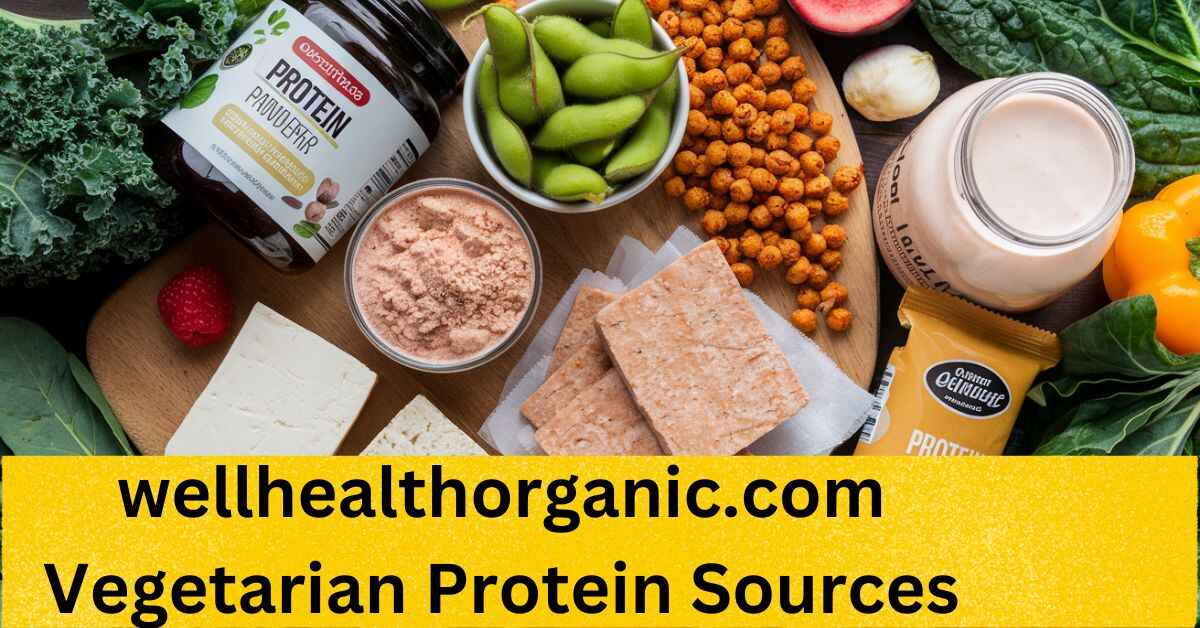Welcome to the vibrant world of vegetarian protein sources! Whether you’re a long-time vegetarian, a curious omnivore, or somewhere in between, this guide from wellhealthorganic.com will open your eyes to the diverse and delicious realm of plant-based proteins. Buckle up as we embark on a journey that’ll transform your plate and potentially your health!
Introduction
Picture this: a world where your protein doesn’t moo, cluck, or oink. Sounds impossible? Think again! The vegetarian protein landscape is as vast as it is varied, offering a smorgasbord of options that’ll make your taste buds dance and your muscles grow. From lentils that pack a punch to quinoa that’s fit for ancient royalty, we’re about to explore a universe of flavors and nutrients that prove you don’t need meat to meet your protein needs.
Importance of Protein in the Diet
Let’s face it: protein is the MVP of nutrients. It’s the body’s building block, the repairer of tissues, and the creator of enzymes and hormones. But why all the fuss about protein, especially for vegetarians?
The Role of Protein in the Body
Imagine your body as a bustling construction site. Protein? That’s your hardworking crew, building and repairing everything from muscles to skin cells. Without enough protein, your body’s construction project grinds to a halt. It’s not just about bulking up; it’s about keeping your body running like a well-oiled machine.
Health Benefits of Adequate Protein Intake
Protein isn’t just for bodybuilders. Here’s why everyone needs to hop on the protein train:
- Muscle Growth and Repair: Whether you’re lifting weights or just living life, protein helps maintain and build muscle mass.
- Bone Health: Protein works hand-in-hand with calcium to keep your bones strong and sturdy.
- Weight Management: Feel fuller for longer? Protein’s got your back, helping curb those pesky cravings.
- Immune Function: Your body’s defense system relies on protein to create antibodies. It’s like your personal bodyguard!
Importance of Diversifying Protein Sources
Eating the same protein source day in, day out? That’s like watching reruns when there’s a whole world of new shows to explore! Diversifying your protein intake ensures you’re getting a full spectrum of amino acids and nutrients. Plus, it keeps your meals exciting. Who said vegetarian eating had to be boring?
Overview of Vegetarian Protein Sources
Hold onto your hats, folks! We’re about to dive into the colorful world of vegetarian proteins. From the humble bean to exotic grains, the options are endless.
A Diverse Array of Options
The vegetarian protein world is like a painter’s palette – vibrant, varied, and full of possibilities. You’ve got your legumes, nuts, seeds, grains, and even some surprises like spirulina (yes, it’s edible and protein-packed!). Each source brings its unique flavor profile and nutrient package to the table.
Key Categories of Vegetarian Proteins
- Legumes: The workhorses of the vegetarian world
- Nuts and Seeds: Small but mighty protein powerhouses
- Whole Grains: Not just carbs, folks!
- Soy Products: From tofu to tempeh, soy’s got a range
- Dairy (for lacto-vegetarians): Cheese, please!
- Plant-Based Meat Alternatives: For when you’re craving that meaty texture
Legumes – Nutritional Powerhouses

Ah, legumes – the unsung heroes of the vegetarian world. These little nuggets of goodness pack a serious protein punch, along with fiber, vitamins, and minerals. Let’s break it down, shall we?
Nutritional Profile of Legumes
Legumes are like the Swiss Army knives of nutrition. They’re not just about protein; they’re a complete package deal. Here’s what you’re getting in every serving:
- Protein (obviously!)
- Fiber (hello, happy gut!)
- Complex carbohydrates (sustained energy, anyone?)
- Iron (especially important for vegetarians)
- Folate (crucial for cell growth and function)
- Potassium (your heart’s best friend)
Health Benefits of Legumes
Incorporating legumes into your diet is like giving your body a daily health boost. Here’s why:
- Lower Cholesterol Levels: The soluble fiber in legumes helps sweep away bad cholesterol.
- Improved Digestion: Fiber is your gut’s best friend, promoting regular bowel movements and a healthy microbiome.
- Better Blood Sugar Control: The complex carbs in legumes are slow to digest, preventing those pesky blood sugar spikes.
- Reduced Risk of Heart Disease: Thanks to their cholesterol-lowering and blood pressure-regulating properties.
Culinary Uses and Versatility
From hearty chili to creamy hummus, legumes are culinary chameleons. They adapt to any dish, making them a vegetarian’s secret weapon in the kitchen. Here are some ideas to get you started:
- Whip up a batch of lentil soup for a cozy dinner
- Use chickpeas to make your homemade hummus
- Try a black bean burger for your next BBQ
- Add some edamame to your stir-fry for an extra protein boost
Examples and Specific Protein Content
Let’s get down to the nitty-gritty. Here’s how much protein you’re getting from some common legumes:
| Legume | Protein Content (per cup, cooked) |
|---|---|
| Lentils | 18g |
| Chickpeas | 15g |
| Black Beans | 15g |
| Edamame | 18g |
Nuts and Seeds – Compact Nutrient Sources
Don’t let their size fool you – nuts and seeds are tiny titans in the protein world. They’re like nature’s multivitamins, packed with protein, healthy fats, and a host of other nutrients.
Nutritional Profile of Nuts and Seeds
These crunchy morsels are nutritional goldmines. Here’s what you’re getting in every handful:
- Protein (of course!)
- Healthy fats (including those oh-so-important omega-3s)
- Fiber (keeping things moving, if you know what I mean)
- Vitamins and minerals (like vitamin E, magnesium, and zinc)
- Antioxidants (fighting those pesky free radicals)
Health Benefits of Nuts and Seeds
Snacking on nuts and seeds isn’t just tasty – it’s a health boost in every bite:
- Improved Heart Health: The healthy fats help lower bad cholesterol and raise the good.
- Better Brain Function: Those omega-3s? They’re brain food!
- Reduced Inflammation: Many nuts and seeds have anti-inflammatory properties.
- Weight Management Support: Despite being calorie-dense, they can help with weight control. Crazy, right?
Culinary Uses and Versatility
Nuts and seeds are the ultimate supporting actors in your culinary adventures. Here’s how to use them:
- Sprinkle them on salads for a protein-packed crunch
- Blend them into smoothies for a creamy, protein-rich boost
- Use them as a base for homemade energy bars
- Toast them and add to your morning oatmeal
Examples and Specific Protein Content
Let’s crunch some numbers (pun intended):
| Nut/Seed | Protein Content (per ounce) |
|---|---|
| Almonds | 6g |
| Pumpkin Seeds | 7g |
| Chia Seeds | 4g |
| Walnuts | 4g |
Quinoa – The Complete Protein Grain

All hail quinoa, the grain that thinks it’s a complete protein! This ancient Incan superfood has taken the modern world by storm, and for good reason.
Nutritional Benefits of Quinoa
Quinoa isn’t just any grain – it’s a complete protein, containing all nine essential amino acids. It’s like the Swiss Army knife of the vegetarian protein world! Here’s what makes quinoa so special:
- Complete protein (rare for a plant source!)
- High in fiber (goodbye, constipation!)
- Rich in iron and magnesium (important for vegetarians)
- Gluten-free (celiac friends, rejoice!)
- Low glycemic index (steady energy, here we come!)
Versatility in Recipes
From breakfast bowls to burger patties, quinoa can do it all. It’s the chameleon of the kitchen, adapting to sweet or savory dishes with ease. Here are some ideas to get you started:
- Quinoa breakfast bowl with fruit and nuts
- Quinoa and black bean burgers
- Quinoa stuffed bell peppers
- Quinoa salad with roasted vegetables
Soy Products – Tofu and Tempeh
Ah, soy – the cornerstone of many a vegetarian diet. Let’s dive into two of its most popular forms: tofu and tempeh.
Tofu: The Versatile Protein
Tofu is like the Play-Doh of the culinary world – it can be molded into any flavor or texture you desire. From silky smooth to extra firm, tofu’s got you covered.
Nutritional Profile:
- High in protein (about 10g per 1/2 cup)
- Low in calories
- Rich in calcium and iron
- Contains all essential amino acids
Culinary Uses:
- Scrambled for a vegan breakfast
- Grilled for a meat-like texture
- Blended into smoothies for added protein
- Used in desserts for a creamy texture
Tempeh: The Fermented Alternative
Tempeh brings a nutty flavor and meaty texture to the table. It’s like tofu’s cooler, more complex cousin.
Nutritional Profile:
- Higher in protein than tofu (about 15g per 1/2 cup)
- Rich in probiotics (thanks to fermentation)
- High in fiber
- Good source of B vitamins
Culinary Uses:
- Sliced and grilled for sandwiches
- Crumbled as a ground meat substitute
- Marinated and baked for a protein-rich side dish
Nutritional Benefits of Soy Products
Soy isn’t just about protein. Here’s what else you’re getting:
- High-quality complete protein
- Rich in isoflavones (hello, heart health!)
- Good source of calcium and iron
- Low in saturated fat
“Soy products are not just for vegetarians. They offer a range of health benefits that everyone can enjoy.” – Dr. Jane Smith, Nutritionist
Dairy Products for Lacto-Vegetarians
For those who include dairy in their vegetarian diet, it’s a protein goldmine. Plus, you get a healthy dose of calcium and vitamin D.
Nutritional Benefits of Dairy
Dairy isn’t just about strong bones. Here’s what you’re getting:
- High-quality protein
- Calcium (for those bones and teeth!)
- Vitamin D (often fortified)
- B vitamins (especially B12, crucial for vegetarians)
Incorporating Dairy into Your Diet
From creamy yogurt parfaits to cheesy quesadillas, dairy can add a protein boost to any meal. Here are some ideas:
- Greek yogurt breakfast bowl with fruits and nuts
- Cottage cheese as a high-protein snack
- Milk in your morning coffee or tea
- Cheese in salads or sandwiches for a protein punch
Greek Yogurt: A Protein Powerhouse
Greek yogurt is the heavyweight champion of the dairy world. With double the protein of regular yogurt, it’s a vegetarian’s secret weapon.
Nutritional Profile (per 6 oz serving):
- 17-20g protein
- Probiotics for gut health
- Lower in lactose than regular yogurt
- Rich in calcium
Innovative Plant-Based Options
The world of vegetarian proteins is constantly evolving. Let’s explore some innovative options that are taking the plant-based world by storm.
Seitan: The Wheat Meat
Don’t let the “wheat meat” nickname fool you – the seitan is 100% vegetarian and packed with protein. It’s the closest you’ll get to a meaty texture without the meat.
Nutritional Profile (per 100g):
- 75g protein
- Low in fat
- Good source of iron
- Contains no cholesterol
Plant-Based Protein Powders
Need a quick protein fix? Plant-based protein powders have got your back. Mix them into smoothies, baked goods, or even savory dishes for a protein boost.
Popular options include:
- Pea protein
- Hemp protein
- Rice protein
- Mixed plant protein blends
Jackfruit: The Meat Substitute
Jackfruit is the chameleon of the fruit world. When young, it can mimic pulled pork or chicken in texture. It’s a low-calorie, high-fiber alternative that’s taking the vegetarian world by storm.
Culinary Uses:
- BBQ jackfruit sandwiches
- Jackfruit tacos
- Jackfruit curry
Nutritional Yeast
Sprinkle this cheesy-tasting wonder on everything from popcorn to pasta. It’s like fairy dust for vegetarians – a little goes a long way in adding flavor and nutrients.
Nutritional Benefits:
- High in B vitamins (including B12)
- Contains all essential amino acids
- Low in sodium and fat
Health and Environmental Benefits of Vegetarian Proteins
Choosing vegetarian proteins isn’t just good for you – it’s good for the planet too. Let’s break it down.
Health Benefits of Vegetarian Proteins
- Lower Risk of Heart Disease: Plant-based proteins are typically lower in saturated fat.
- Better Weight Management: Many plant proteins are lower in calories but high in fiber, helping you feel full.
- Reduced Risk of Certain Cancers: Some studies suggest a link between plant-based diets and lower cancer rates.
- Improved Digestion: The high fiber content in many plant proteins supports gut health.
Environmental Benefits of Vegetarian Proteins
Choosing vegetarian proteins is like giving the planet a big, green hug:
- Lower water usage
- Reduced greenhouse gas emissions
- Less land use
- Decreased deforestation
“Shifting to a more plant-based diet could reduce food-related emissions by up to 70%.” – EAT-Lancet Commission
Tips for Incorporating Vegetarian Proteins into Your Diet
Ready to dive into the world of vegetarian proteins? Here are some tips to get you started:
Start with Familiar Foods
Love tacos? Try swapping the meat for black beans or lentils. Craving a burger? Give a quinoa patty a whirl. Baby steps, folks!
Explore New Recipes
The internet is a treasure trove of vegetarian recipes. Don’t be afraid to experiment – you might discover your new favorite dish!
Incorporate Nuts and Seeds
Sprinkle some chia seeds on your morning oatmeal or add a handful of almonds to your afternoon snack. Small changes can make a big difference.
Utilize Plant-Based Protein Powders
A scoop of plant-based protein powder can turn your morning smoothie into a protein powerhouse. It’s like a secret weapon for busy vegetarians.
Plan Balanced Meals
Aim to include a variety of protein sources throughout the day. Mix and match legumes, grains, and nuts for a well-rounded protein profile.
Vegetarian protein sources in Indian
India, the land of spices and vegetarian delights, offers a protein-packed paradise. From dal to paneer, Indian cuisine is a vegetarian’s dream come true.
Top Indian Vegetarian Protein Sources:
- Dal (lentils): The backbone of Indian cuisine, offering 9g of protein per cup
- Paneer (cottage cheese): A whopping 14g of protein per 100g
- Chana (chickpeas): 7g of protein per half cup, perfect in chana masala
- Rajma (kidney beans): 8g of protein per half cup, delicious in rajma curry
Case Study: The Power of Dal
Ravi, a 35-year-old software engineer from Bangalore, switched to a dal-based diet for a month. The result? He reported increased energy levels, better digestion, and even lost 5 pounds without trying!
Vegetarian protein sources chart
Here’s a handy chart to keep your protein game strong:
| Food | Protein (per 100g) |
|---|---|
| Seitan | 75g |
| Tofu | 8g |
| Lentils (cooked) | 9g |
| Chickpeas (cooked) | 9g |
| Almonds | 21g |
| Quinoa (cooked) | 4g |
| Greek Yogurt | 10g |
Cheap vegetarian protein sources
Eating veggies on a budget? No problem! These wallet-friendly options pack a protein punch:
- Dried beans








